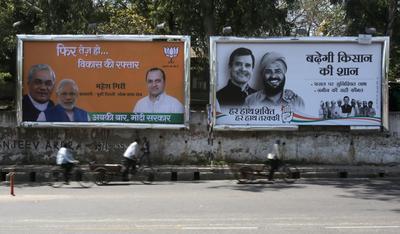The impact of these developments is clear. Statistics show that the wealthier the candidate (as indicated by their declaration of assets at the time of nomination), the greater his/her chance of winning. Interest groups and political dynasties that are best placed to marshal resources have grown disproportionately important within parties and, as a consequence, intra-party democracy has withered. It is no accident that the leaders of the national parties either belong to a dynasty (Rahul Gandhi of the Congress) or enjoy the support of corporate business groups (Narendra Modi of the Bharatiya Janata Party). Regional parties are invariably controlled by families.
The Election Commission discourages ‘excessive’ spending in election campaigns by prescribing expenditure limits. At present, a parliamentary candidate can spend up to ₹ 5.4 million in small states and union territories, while the limit for bigger states is ₹ 7 million. The corresponding limits for state assembly seats are ₹ 2 million and ₹ 2.8 million, respectively. Candidates are also required to open separate bank accounts to manage election expenses, and observers are appointed to monitor ‘day to day account’ transactions. The Commission also conducts extensive raids to restrict the movement of unaccounted money.
Such measures are targeted at individual candidates, not parties. Under the current rules, parties can still spend additional amounts as long as they do not target any specific candidates. There are at least two problems with this: larger parties enjoy economies of scale in advertising spending, and have access to better transport facilities. The first problem could be addressed by banning private advertisements and asking public broadcasters to provide all candidates with adequate advertisement slots. The second could be remedied by asking public transport authorities to provide equitable access to all candidates.
Neither solution is particularly complex, so tackling the influence of money in elections should be easy.
Unfortunately, in reality, most candidates spend much more than the prescribed limits, and the amount spent by major national and regional parties is anyone’s guess. For instance, in 2013, Gopinath Munde, a well-known parliamentarian and a former minister, admitted that he spent more than 32 times the limit in the last election. Many believe that even this sum is an understatement.
At the heart of the problem is the fact that the largest share of candidates’ election expenses (both declared and undeclared) goes to community leaders and local political leaders who are critical to winning elections. In India, community continues to be one of the most important determinants of voters’ political orientation, particularly in rural areas and poorer neighbourhoods within cities. This reduces the effectiveness of any movement toward state funding of elections: candidates would still have to outspend their competitors to win over the local leaders and their supporters. State funding would also create another layer of bureaucracy and spawn a new kind of corruption.
So long as candidates need to buy the support of local leaders, there are few mechanisms capable of encouraging candidates to declare the full extent of their actual spending. In the long-term, painstaking tax reforms to curtail the circulation of black money and sustained voter education could make a difference by addressing both the supply and demand sides of the problem.
But there are also a number of measures that could be implemented in the short-to-medium term.
First, the size of constituencies could be reduced to make them more manageable. This would also make legislators more accessible to the people. But it would require a constitutional amendment to prepone the next round of delimitation which is currently scheduled to take place following the first census after 2026.
Second, spending limits should be linked to determinants of expenditure like the size of the electorate, the area and the terrain of constituency, the density of road and telecommunication networks within the constituency, and the level of literacy and ethno-linguistic diversity among constituents. This upper limit should also be linked to inflation. At present, limits are broadly determined by the size of states, which is only indirectly related to the average size of electorates. Additionally, limits are revised only once every few years.
Third, violations of spending limits need to be decriminalised and replaced with civil penalties, such as punitive tax assessments. The current system provides candidates with an incentive to lie, even if some want to admit that they have over-spent.
Fourth, smaller parties and independent candidates should be provided with greater access to public broadcasters and public transport and telecommunication facilities. This would help to break the stranglehold of big parties bankrolled by corporate business groups.
Reform of India’s current election structure is urgently needed. The existing legal and institutional set-up creates a number of perverse incentives which subvert the ideal of a fair and transparent electoral system. A combination of some of the short- and long-term solutions discussed above may go a long way toward curtailing the importance of money power in elections.
Vikas Kumar is Assistant Professor of Economics at Azim Premji University, Bangalore.

